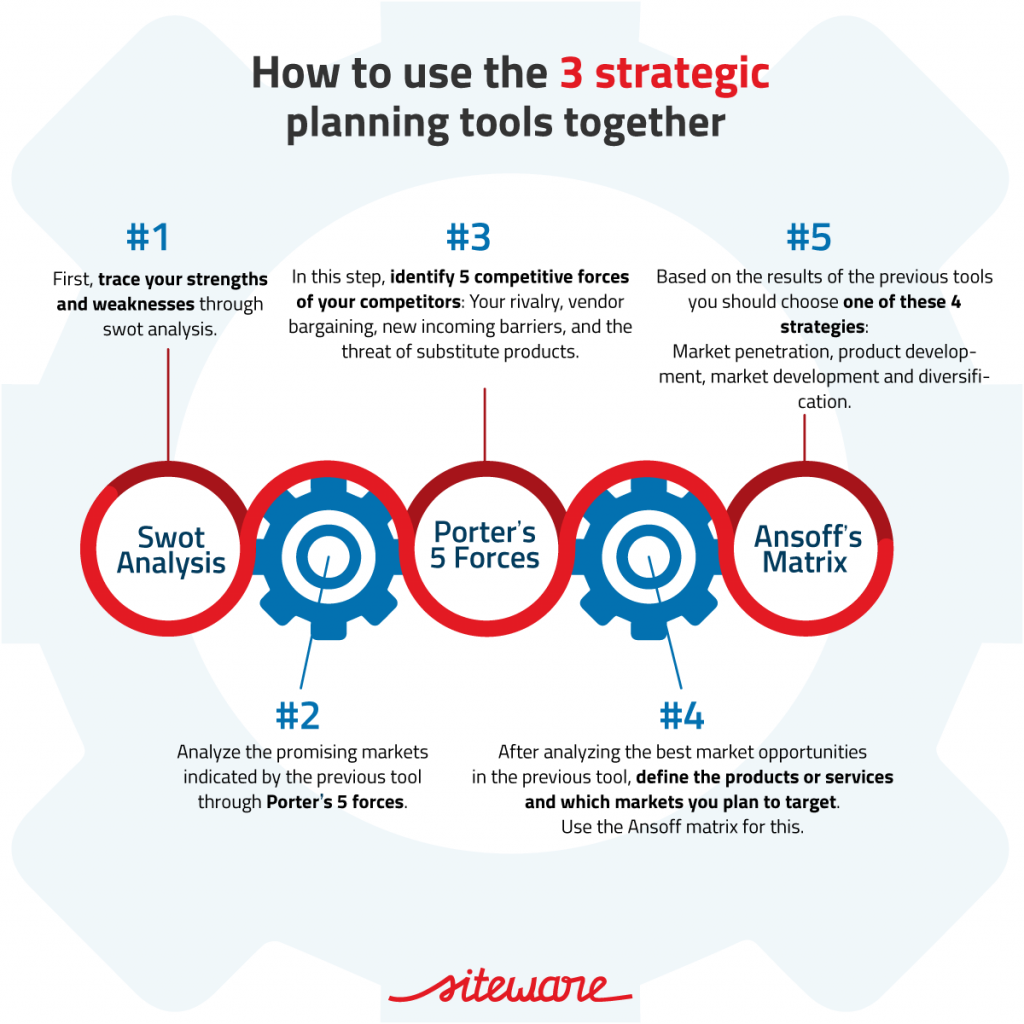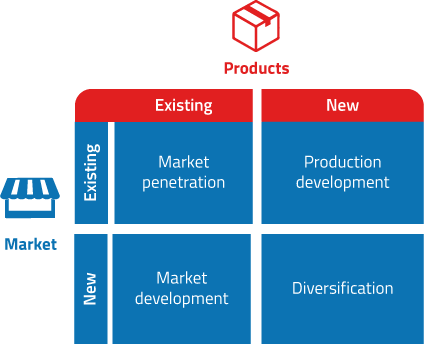Prepare your toolkit for strategic business planning

Conteúdo
When talking about strategic business planning tools, most people quickly remember the famous SWOT matrix, and some suggest Porter’s 5 competitive forces, but the very important Ansoff Matrix is remembered by only a few.
In this post, understand how to use these tools for strategic planning together, and get the best results.
3 strategic planning tools you should know how to use together
Starting with SWOT analysis makes a lot of sense. Then analyzing the strengths of the markets in which you want to enter, and finally use the Ansoff matrix to define how and with what products or services you want to place in the chosen markets.

1- SWOT Analysis
Probably the best known of the strategic planning tools, SWOT analysis studies the internal environment of the company (the one you can control) in search of its strengths and weaknesses, and also investigates the external environment (which your company can not control) to identify opportunities and threats.
The strengths of a company can be its brand name, a skilled workforce, its location, the mastery of certain technologies or having state of the art production of goods or equipment.
Weaknesses may be the same examples, only in the sense that the company does not perform well in these areas and needs to improve them.
The external environment is usually analyzed through the PESTEL analysis, an acronym for the following factors:
- Political
- Economic
- Social
- Technological
- Ecological
- Legal
Thus, a new economic regulation which lowers taxes and a favorable political climate for the lowering of interest rates, for example, can be considered opportunities for a company, while the restriction of the emission of CO2 in its factory plant (ecology) or a law that prohibits the use of a certain preservative your company uses, are threats.
It is up to SWOT analysis to define how your strengths will potentialize opportunities and defend your company from threats, and what weaknesses need to be strengthened so as not to amplify the threats or undermine the opportunities.
2- Porter’s 5 competitive forces
Has your SWOT analysis indicated some promising markets? Great, analyze them with the help of Porter’s 5 competitive forces, one of the tools for strategic planning that can not be missing from your toolkit.
Understand how competitive forces work:
- Rivalry between competitors:The greater the rivalry, the harder it will be to enter a market, because those who are already there invest heavily in marketing and research, in addition to operating with low margins.
- Clients’ bargaining power: When buyers have a number of similar options to choose from or have time to make a buying decision, they can pressure the market to lower prices and increase the quality of products and services.
- Bargaining power of suppliers: There are typical monopoly or oligopoly situations, when suppliers practically dictate prices and conditions, but other factors may increase or decrease suppliers’ bargaining power, such as the degree of differentiation among them, the cost of production and to the possibility of a supplier one day becoming a competitor.
- Threat of new entrants: Does the market have entry barriers, or is it easy to be part of? Patents, high installation costs, economies of scale and the strength of already instilled brands are some of the factors that can determine the degree of threat of new competitors saturating a market quickly.
- Threat of substitute products: Think about how Uber has replaced conventional taxis and the Waze app has put an end to the automotive GPS market. Substitute products serve the same needs of their customers, only in a different and sometimes better way.
After analyzing which of the market opportunities are most likely to be harnessed by the 5 competitive forces, define with which products or services and which markets you plan to target. Use one more of the great tools of strategic planning, the Ansoff matrix.
To help with this analysis, good marketing research can help a lot.
3- Ansoff Matrix or the Product Market Matrix
Another great tool for strategic planning! Basically, based on your strengths and weaknesses, opportunities and threats, and the degree of market competitiveness, you must decide whether to use one of these 4 strategies:
- Market Penetration: Your company decides to stay in the market it is in, in an attempt to win over new customers, but will not create new products or services for that.
- Product Development: In this case, your company detects the opportunity to create new products to offer in the market where it already operates.
- Market Development: This strategy consists of launching the products that your company already markets, but in other markets that you want to conquer.
- Diversification: Launching new products into new markets.
These decisions will depend on previous reviews. For example: if a market has been detected where competitive forces are favorable and your company is strong in marketing and innovation, it may be interesting to opt for diversification.
And if your brand is strong and well known in your market and your company goes through a time when the development of new products or services is a weak point, market penetration can be a smart direction.
Do you completely understand how the last of our strategic planning tools works?

Revolutionize the management of your company with STRATWs One
